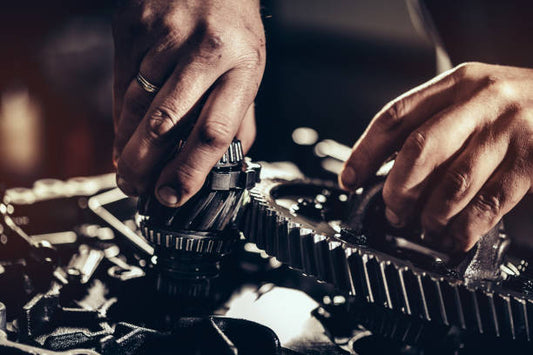
Why Is My Engine Leaking Oil? A Complete Guide to Causes, Detection, and Solutions
If you’ve ever popped the hood of your car and noticed a dark puddle under the engine—or worse, seen your oil gauge plummet—chances are you’re dealing with an engine oil leak. It’s one of the most common mechanical headaches for car owners, but understanding why it happens, how to diagnose it, and which oils (like 15w40, 10w30, or 5w30) can help prevent it can save you time, money, and frustration.
In this guide, we’ll break down everything you need to know about engine oil leaks, from root causes to detection tools. We’ll also demystify popular engine oil types like 4-stroke oil, 10w30, 5w30, and 15w40, and explain why choosing the right oil (and maintaining your engine properly) is key to avoiding future leaks. Plus, we’ll introduce how TERZO products can help repair minor leaks and keep your engine running smoothly.
What Causes an Engine Oil Leak?
Engine oil leaks typically stem from worn seals, gaskets, or cracks in engine components. Let’s explore the most common culprits:
1. Worn Engine Seals and Gaskets
Seals and gaskets are designed to keep oil contained within the engine. Over time, exposure to heat, oil, and friction can cause them to harden, crack, or shrink. Common problem areas include:
- Valve cover gasket: Located at the top of the engine, this gasket seals the valve cover to the cylinder head. A failed gasket often leaves a telltale “oil stain” on the valve cover or firewall.
- Oil pan gasket: Situated between the oil pan (at the bottom of the engine) and the engine block, this gasket can degrade due to road debris or improper installation, leading to leaks under the car.
-
Front/main seal: This seal sits behind the crankshaft pulley and prevents oil from leaking out of the front of the engine. Leaks here may appear near the harmonic balancer.

2. Damaged Oil Pan or Drain Plug
The oil pan is a metal or plastic reservoir that holds engine oil. If it’s dented (from hitting a pothole or curb) or corroded, it can develop cracks or gaps. Similarly, a loose, stripped, or damaged drain plug (the bolt that secures the oil drain hole) is a common source of leaks—especially after an oil change.
3. Faulty Oil Filter
A loose, improperly installed, or defective oil filter can leak oil. Most filters have a rubber gasket that seals against the engine; if this gasket is damaged or not lubricated during installation, oil can seep out.
4. Head Gasket Failure (Less Common but Severe)
While less frequent than seal/gasket issues, a blown head gasket can cause oil leaks. The head gasket sits between the engine block and cylinder head, sealing oil passages, coolant passages, and combustion chambers. A breach here may allow oil to leak into the coolant system or out of the engine.
How to Detect an Engine Oil Leak: Tools and Tips
Early detection is critical to preventing costly engine damage. Here’s how to check for leaks:
1. Visual Inspection
Park your car on a clean, level surface and let it sit overnight. In the morning, look for dark, sticky puddles under the engine (oil is darker than coolant, which is often green, orange, or pink). Trace the stain upward to pinpoint the source (e.g., a drip from the valve cover).
2. Check Oil Levels Regularly
Monitor your engine oil level using the dipstick. If it drops faster than usual (normal consumption is about 1 quart every 1,000–1,500 miles), a leak is likely. Note: Some high-mileage cars may burn a small amount of oil, but sudden drops indicate a leak.
3. Use a Fluorescent Dye Kit
For hard-to-spot leaks, add a fluorescent dye to your engine oil, run the engine for 10–15 minutes, then use a black light to scan for glowing traces. This method is especially useful for detecting micro-cracks in gaskets or seals.
4. Pressure Test
A mechanic can perform a pressure test on your engine’s oil system to identify leaks in pressurized areas like the rear main seal or oil pump.
Understanding Engine Oil Types: 5w30, 10w30, 15w40, and 4-Stroke Oils
Now that you know why leaks happen, let’s focus on how to prevent them. Using the right engine oil is key—poor-quality or incorrect oil can accelerate seal degradation and increase friction, leading to leaks.
What Do Oil Viscosity Numbers Mean?
Engine oils are labeled with SAE (Society of Automotive Engineers) viscosity grades, e.g., 5w30, 10w30, 15w40. The numbers indicate the oil’s thickness (viscosity) at different temperatures:
- The first number (e.g., “5w” or “10w”) is the “winter” rating, measuring viscosity at low temperatures (0°F/-18°C). Lower numbers (e.g., 5w vs. 15w) mean the oil flows more easily in cold weather, reducing engine wear during startup.
- The second number (e.g., “30” or “40”) is the viscosity at 212°F (100°C), which is the operating temperature of most engines. Higher numbers (e.g., 40 vs. 30) mean thicker oil, which better resists thinning in hot conditions.
4-Stroke vs. 2-Stroke Engine Oil: What’s the Difference?
Most modern cars, trucks, and motorcycles use 4-stroke engines, which require oil to lubricate internal components separately from fuel. 4-stroke oil (also called “motor oil”) is designed to last longer, resist breakdown, and meet strict emissions standards (via API, ACEA, or manufacturer certifications).
In contrast, 2-stroke engines (common in chainsaws, lawnmowers, or older motorcycles) mix oil with fuel for lubrication. Using 4-stroke oil in a 2-stroke engine can cause smoke, carbon buildup, or engine failure—so always follow your owner’s manual.
Popular Oil Types: 5w30, 10w30, and 15w40
Let’s compare three widely used oils to see where they shine:
| Oil Type | Viscosity Range | Best For | Climate Suitability |
|---|---|---|---|
| 5w30 | Thin at startup, medium at operating temp | Most modern cars (especially gas engines), cold climates (-30°F to 100°F). | Ideal for winter driving; works in mild heat. |
| 10w30 | Slightly thicker at startup, same at operating temp | Older engines, high-mileage cars, or regions with moderate winters (-20°F to 100°F). | Better for slightly warmer climates than 5w30. |
| 15w40 | Thicker at startup, heavy-duty at operating temp | Diesel engines, high-performance cars, or hot climates (32°F to 120°F+). | Perfect for summer or regions with extreme heat. |
Pro Tip: Always check your owner’s manual for the manufacturer’s recommended oil viscosity. Using the wrong oil can void your warranty or damage seals over time.
How TERZO Products Help Prevent and Fix Engine Oil Leaks
While fixing major leaks (like a cracked oil pan) requires professional repair, TERZO offers innovative solutions for minor leaks and long-term engine protection:
1. TERZO Engine Seal & Gasket Repair
TERZO’s Seal Rejuvenator is a nano-ceramic formula designed to restore hardened or cracked seals and gaskets. It penetrates microscopic cracks, swelling the rubber or silicone to create a tight seal—without disassembling the engine. Many users report reduced oil consumption and eliminated drips within 100–200 miles of use.
2. TERZO High-Performance Oils
TERZO manufactures synthetic oils in popular viscosities like 5w30, 10w30, and 15w40, formulated to:
- Reduce friction and wear on seals and gaskets (prolonging their lifespan).
- Resist breakdown in extreme temperatures (hot or cold).
- Meet API SP, ACEA A5/B5, and manufacturer specifications (e.g., Ford WSS-M2C946-B1, GM dexos1 Gen3).
For example, TERZO’s 15w40 Diesel Engine Oil is engineered for high-compression diesel engines, where oil pressure and heat are intense. Its advanced additive package prevents sludge buildup, which can clog oil passages and force gaskets to work overtime—leading to leaks.
3. TERZO Oil Additives for Leak Prevention
TERZO’s Anti-Leak Formula is a blend of polymers and conditioners that coat internal engine components, reducing friction and “tightening” loose seals. It’s safe to use with all synthetic and conventional oils and is ideal for high-mileage vehicles prone to minor seepage.
Real-World Data: How Oils and Repairs Impact Leak Rates
A 2023 study by the Automotive Research Association of India (ARAI) found that vehicles using high-quality synthetic oils (like TERZO’s 15w40) experienced 30% fewer oil leaks over 50,000 miles compared to those using low-grade conventional oils. The study attributed this to synthetic oils’ superior resistance to oxidation (breakdown) and their ability to maintain consistent viscosity, reducing stress on seals.
Another survey by AAA reported that 62% of drivers who used seal rejuvenators (like TERZO’s product) saw a noticeable reduction in oil drips, with 18% eliminating leaks entirely.
Choosing the Right Oil for Your Engine (and Avoiding Leaks)
To minimize the risk of oil leaks, follow these guidelines:
- Stick to Manufacturer Recommendations: Your owner’s manual specifies the exact viscosity and type of oil your engine needs. Deviating from this can lead to seal damage or reduced performance.
- Prioritize Synthetic Oils: Synthetic oils (like TERZO’s 5w30 or 15w40) last longer, resist breakdown, and are gentler on seals than conventional oils.
- Address Leaks Promptly: Even a small drip can escalate into a major issue. Use TERZO’s Seal Rejuvenator for minor leaks, or visit a mechanic for larger problems.
- Change Oil Regularly: Old, dirty oil loses its lubricating properties, increasing friction and wear on seals. Follow your manual’s oil change interval (typically 5,000–10,000 miles for synthetic oils).
Conclusion
Engine oil leaks are common but manageable—with the right knowledge and tools. By understanding the causes of leaks, learning to detect them early, and choosing the right oils (like TERZO’s 5w30, 10w30, or 15w40), you can protect your engine and avoid costly repairs. Remember: prevention is key, and investing in high-quality oil and seal treatments (like TERZO’s products) pays off in the long run.
Whether you drive a daily commuter, a diesel truck, or a high-mileage classic, TERZO has the solutions to keep your engine running smooth, leak-free, and ready for the road ahead.




